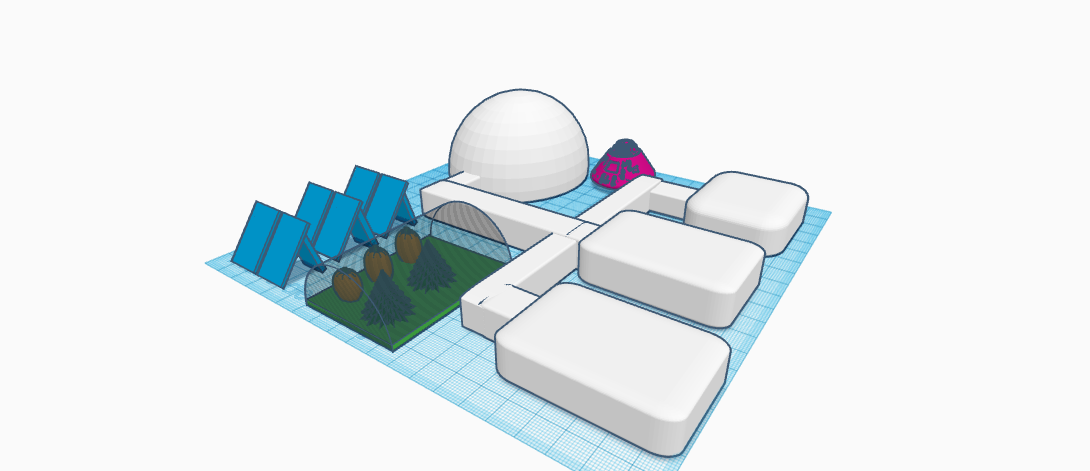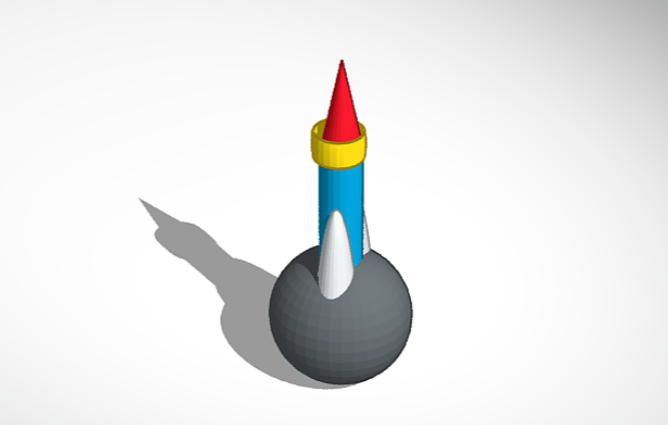Moon Camp Discovery 2021-2022 Project Gallery
All | Lunar lander | Moon Base | Lunar rover | Rocket | Lunar Orbital Space Station | Space Suit
Team: Noah Murray
Category: Moon base | Shrewsbury | United Kingdom | 1 | 15 years old
External link for Tinkercad 3D design
Moon Camp Challenge (Discovery), Moon Base Submission
Technical Notes
The Following Document is intended to provide a more detailed descriptor and reasoning for design choices
made in the following submission.
The naming is equivalent to the naming used in the notes placed on the 3d model.
Domes (A, B, C) are intended to be multirole and have overlapping functions to increase safety and redundancy.
The intended construction would be of nonmetal carbon composites to reduce transport cost and with additional
spaced layers of polymer to both increase thermal control and to provide a level of protection against
micrometeorite impacts, regolith, and radiation. Dome A would house primary habitation, this would need to be
most of the dome’s space as long term habitation would require a large amount of space to prevent immense
psychological difficulties, as well as research facilities (combined with living space) and by proxy the primary life
support systems of air regulation and water recycling. Dome B would be focused on ISRU (In-Situ resource
utilisation) and therefore have facilities required to use lunar resources such as metals in its metallic crust to
expand on the base. It would also house any systems for processing deuterium if that was found in sufficent
abundance and fission technology had advanced enough to warrant it. Dome C would contain seacondary
habitation that would serve as extra crew capacity aswell as providing a backup should dome A be damaged.
Finally, Dome C would also house the electrolysis facilities needed to process lunar ice into useable hydrogen
and oxygen for both propulsion and use in life support aswell as seacondary life support for its habitable areas,
although these facilities would be able to support dome A if needed. In all three domes supplies would be stored
around the edge of the dome and in the upper areas to act as additional radiation shielding. It is also possible
that if the base’s ISRU can produce concrete from regolith then this could be used as a coating to reduce
radiation exposure.
The Interlinks (1, 2, 3) would be constructed of the same materials and be separately pressurised; 1 would house
hydroponic farms to produce food and remove carbon dioxide, 2 would house supplies and medical facilities
aswell as any fitness equipment needed to prevent long term degradation of heath that is brought on by low
gravity and 3 would house emergency power storage in the form of batteries and potentially a RTG (Radioisotope
Thermoelectric Generator) for use when solar exposure was limited (although it is theorised that this base would
be located in a polar region where solar power is near-continuous), 3 would also house any transformers and
regulators needed for the base’s solar arrays to function.
4 Is the Long-Range radio antenna, this is for use in communication aswell as potentially making radio
observations if needed.
5 Is the support craft storage bay, to house lunar buggies for short range transport aswell as any craft needed for
ISRU (for mining ice and metals). This features onboard solar arrays to charge these vehicles and is constructed
from the same materials as the domes. It also provides these craft with protection from long term radiation
damage and regolith.
6 Is the landing pad for shuttles that would be used to transport supplies/crew and access more remote areas of
the moon. The pad also is important to prevent too much regolith from being kicked up during landing/take-off as
this would damage other equipment, and this is also the reason for its distance from the rest of the base. The pad
also houses arms to attach to and refuel compatible craft.
6.1 Represents a smaller, pressurised tunnel for accessing the pad. It can also be used for storing supplies when
space in dome B is not available.
7 Are the two liquid hydrogen tanks. Hydrogen is needed in lesser quantities than oxygen as the stochiometric
ratio of hydrogen to oxygen is 1:8 and oxygen is also needed for life support. However, the large amounts of
hydrogen produced by electrolysis may also be used to cool the domes to prevent overheating, so a moderate
amount of liquid hydrogen is appropriate. 8 & 9 therefore is the six corresponding liquid oxygen tanks. There are
multiple tanks used for redundancy.
10 – 13 Are the large solar arrays needed to power the base, specifically to produce the vast quantities of power
needed for electrolysis and ISRU. Please note that due to the position of the base at a lunar pole, there would not
be enough benefits from allowing the panels to track in comparison to the increased number of moving parts,
complexity, and weight.






